
© Aleksandar Antonijevic. (Click image for larger version)
National Ballet of Canada
Giselle
Toronto, Four Seasons Centre for the Performing Arts
15 June 2016: ★★★★★
16 June 2016: ★★★★✰
national.ballet.ca
The National Ballet of Canada’s production of Giselle, which concluded the company’s season in Toronto, is a jewel of a ballet. This production was made for NBoC in 1970 by British choreographer Peter Wright, who has created variants of the same version for several companies, including London’s Royal Ballet. Everything about this staging, from its storybook, picturesque decorations and lavish period costumes to its vividly rendered choreography, brilliantly sustains the atmosphere – and the essence – of the Romantic style. It takes the audience in spirit back to 1841 in Paris, where the original Giselle was born.
Wright based his version on the traditional choreography of Jean Coralli and Jules Perrot, and its later revisions by Marius Petipa. Blending realism and mystery, the ballet tells the tragic story of a young peasant girl who falls for the good looks and sweet promises of a deceitful aristocrat disguised as a local villager and who subsequently loses her mind and her life when his deception is revealed. Although nearly half a century since its creation, this magnificently realized production still looks poignant and fresh, speaking eternal truths about passion, betrayal and forgiveness; the ballet’s timeless themes still resonate with modern audiences.
During my stay in Toronto, I was able to see two casts, each offering an immensely captivating yet dissimilar interpretation of the roles of Giselle and her lover Albrecht.
On opening night, Svetlana Lunkina in the title role gave one of those unique performances in which the ballerina completely disappears into her heroine, putting her entire living self into the role. To watch her dance was to witness a consummate artist in top form, whose dancing and acting took the audience deep inside the dramatic logic of the ballet – a thrilling and unforgettable theatrical experience.
A former Bolshoi ballerina (she performed with the eminent Russian company for nearly 16 years), the 36-year-old Lunkina joined the National Ballet of Canada in 2014 and is one of the company’s brightest stars. Her refined and delicate dancing style, together with the naturalness, purity and simplicity of her expression, make her an ideal interpreter of Giselle.

© Aleksandar Antonijevic. (Click image for larger version)
In the first act, her Giselle was gentle and shy, utterly artless and naïve. As the village girl, Lunkina never became a larger-than-life stage presence, communicating in her dancing not only her heroine’s emotional fragility but also her physical frailty.
When this Giselle met the irresistibly good-looking Albrecht (the superb Harrison James), she immediately averted her gaze as if being at once frightened and ashamed; her insecurities told her that this handsome young man couldn’t possibly find her attractive. Throughout Act I, her courtship with Albrecht was full of intricate and charming details, all finely revealed in the dancers’ body language, gestures and glances. Whether the couple was dancing during the harvest celebration or playing a daisy fortune-telling game, you could feel Giselle’s growing attraction to her mysterious admirer.
When the true name of Albrecht, now her fiancé, was finally revealed, it felt as if Lunkina’s Giselle had lost everything she had, including her desire to live, at that very same moment. Her collapse on the floor looked so sudden and so devastatingly real – one couldn’t help but wonder if she was all right and would find strength to go on. When she did get up on her feet, this Giselle was virtually unrecognizable, her face paper-white, her stare blank, her body broken. Her madness-suicide scene was deeply harrowing in its intensity and realism.
With his good looks and supremely elegant dancing, a newly-minted principal, Harrison James played Albrecht as a narcissist and a flirt – a golden boy out for a good time who knew that no village girl could possibly resist his radiant smile and courteous manners. Yet, as the first act took its course, the attitude of the young man began to change, the smugness on his face fading; and when Giselle died in his arms, you could see the pangs of remorse and sorrow reverberated through his entire body. James’s acting as well as his dancing was top notch: genuine, unforced and insightful.
In the second act, in which Giselle was reincarnated as a ghostly spirit, the physical and dramatic transformations of both leads were utterly striking.
With her metaphysical shift, Lunkina’s Giselle acquired serene glamour and royal bearing. Dressed in a pure white long tutu, she looked absolutely stunning. James’s Albrecht, no longer a playboy, looked as if he had been mellowed and aged by his grief. Danced with lyrical tenderness and utter musicality, their heart-rending duet became the epitome of their characters’ love story, and the ballet’s most poignant moment. Supremely elegant and poised, Lunkina floated in her partner’s sensitive arms as if being weightless, flowing on air.
Piotr Stanczyk gave an imposing, full-blooded performance of Giselle’s forsaken suitor, Hilarion, making his character look like a temperamental brute and a bully. Dancing with wonderful authority, Heather Ogden was a menacing, implacable Myrtha, Queen of the Wilis; and the ensemble of white-clad spirits brought power and ardor to their dancing, looking perfectly unified in their vigorous display of female fury unleashed.
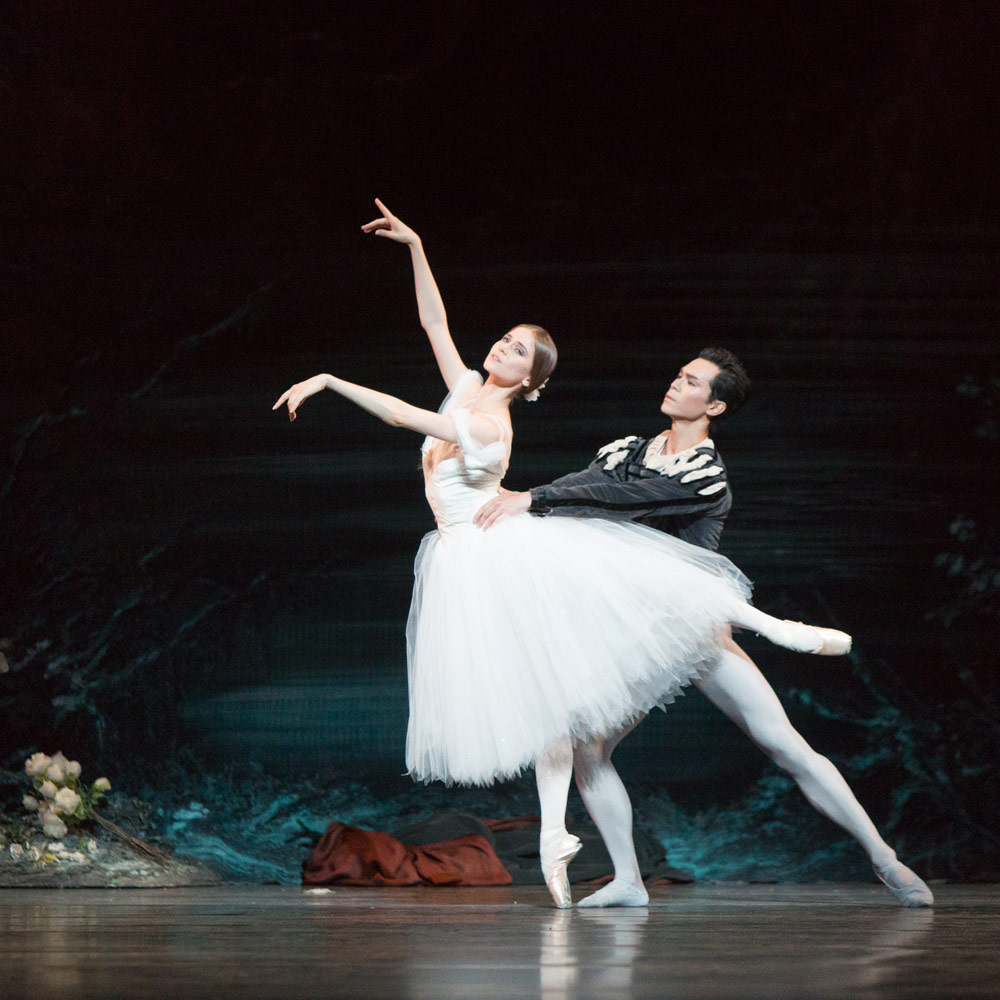
© Aleksandar Antonijevic. (Click image for larger version)
On the following night, the leads were Elena Lobsanova and Naoya Ebe. Both delivered an absorbing reading of their roles, yet if their dancing was flawless, their acting never quite reached the dramatic intensity of the opening night’s performance.
In Act I, Lobsanova’s Giselle was bubbly and outgoing – anything but modest and reserved. Her heroine was genuinely modern in tone and attitude. She teased and flirted with Albrecht, explicitly encouraging his advances with her playful footwork and coquettish glances. A beautiful and intelligent dancer, Lobsanova was in total control of her technique, rendering the choreography with remarkable clarity; the loveliness of her gestures and the buoyancy of her leaps echoed her heroine’s sweet and cheerful personality. In her madness, her heroine seemed visibly devastated and horror-stricken; yet the entire scene felt somewhat muted.
Naoya Ebe’s Albrecht was genuinely smitten with Lobsanova’s Giselle. He played his character as an affable young man who disregarded his status and social responsibility and just followed his heart – a perfectly valid reading of the role. Ebe is a graceful and prodigious dancer, with a long classical line and a high, airy jump; yet his pantomime wasn’t expressive enough to leave a strong theatrical impression.

© Aleksandar Antonijevic. (Click image for larger version)
In the second act, as the thwarted lovers, Lobsanova and Ebe came into their own; the tragedy of their forlorn romance was poignantly explicit in the purity and gentle melancholy of their dancing.
Alexandra MacDonald made a strong impression in her debut in the role of Myrtha; Jonathan Renna rendered Giselle’s hapless suitor Hilarion with a sympathetic touch; and Selene Guerrero-Trujillo, Rui Huang, Christopher Gerty and Ethan Watts infused this ill-fated story with a ting of festive mood in the first act’s exuberant Pas de Quatre.








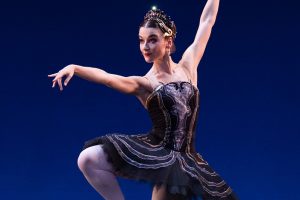

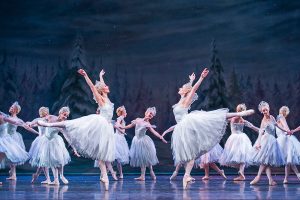
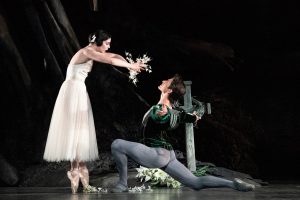
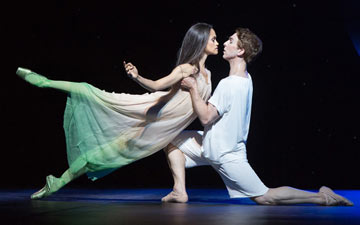


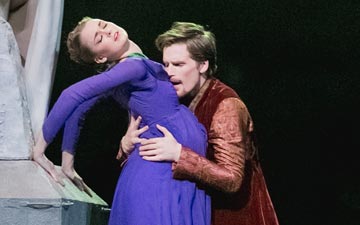
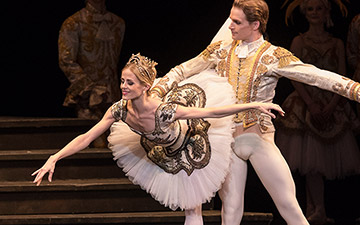
You must be logged in to post a comment.